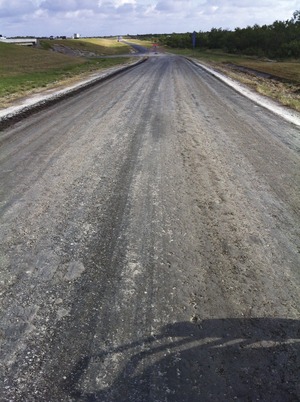

Thanks to the energy boom in central and west Texas, heavy trucks carrying oil and natural gas are tearing up rural farm-to-market roadways that were never intended to bear such 100,000-lb loads. Since the Texas Dept. of Transportation doesn't have the funding to maintain more than 80,000 miles of roads across the Lone Star State, it plans to "unpave" 83 miles of damaged roads.
For now, TxDOT plans to convert its damaged road surfaces in central and west Texas. Only two roads—a three-mile stretch of I-37 frontage road in Live Oak County and a portion of Farm-to-Market Road 1916 in Dimmit County—have been converted to "high-end unpaved roads."
But following the widespread local outcry on Aug. 28, TxDOT gave county officials a 60-day review period on plans to convert damaged roads to unpaved roads in Texas' energy-producing areas before actually moving forward with the conversion work.
"At some point, when drilling activity has subsided and more funding is available, we plan to rebuild these roads to paved farm-to-market levels," TxDOT Executive Director Phil Wilson said in a statement. "The unpaved roads are a temporary solution."
In an updated 2011 report, the Texas Transportation Commission's so-called 2030 Committee said the state's unmet transportation funding needs are now at $4 billion a year, with $1 billion for maintenance and $3 billion for mobility.
"These aren't cost-cutting measures—what that is, is a statement that we've been trying to communicate for years now. The state has only given TxDOT one-third of the money to do what they need to do in this state," says Bob Lanham of Williams Bros. Construction Co. Inc., who is chairman of the Associated General Contractor's (AGC) Highway Funding Task Force. "These are very difficult decisions, but [TxDOT is] strapped for resources."
Tom Johnson, AGC of Texas executive vice president, says the $4 billion estimated for annual needs is "just to stay where you are now with the same degree of mobility. You need to take that on up to $7 billion or $8 billion if you would like to do away with heavy congestion in metropolitan areas like Houston and Dallas."
On Aug. 1, Wilson testified before the Texas House Select Committee on Transportation Funding, saying, "We are already $1 billion below where we need to be. In 2016, our production will fall to $2.5 billion, leaving us $4 billion short."
TxDOT also is considering turning back to cities and counties maintenance of more than 100 miles of state highways, which would amount to $165 million in cost savings.
Some help could come next November, when a ballot proposition will give voters the chance to take a little more than $1 billion out of the state's rainy-day fund to be used for transportation infrastructure. Still, "that's only meeting about 25% of current projected needs," Lanham says.
The agency also is implementing a rigorous cost-savings program that includes privatizing IT services, saving $30 million a year; reducing its fleet to 10,000 vehicles from 16,000, saving $50 million a year; and switching from traditional motor oil to synthetic motor oil, saving $1.4 million a year.
"These are rural roads with low-density traffic on them. But can we afford, as a state, to build something to highway or interstate standards out in the middle of nowhere just to carry an oil-field truck?" Lanham says.



Post a comment to this article
Report Abusive Comment